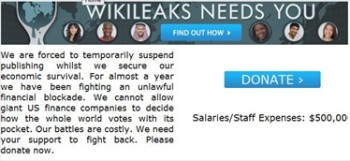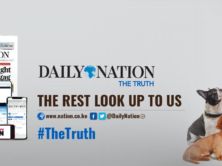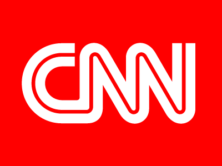
WikiLeaks is calling for donations in order to continue publishing. (Credit: WikiLeaks, screenshot)
WikiLeaks needs money. It announced it may shut down and has suspended publishing because of a lack of funds, the Associated Press reported.
Instead of publishing, the site will try to raise money, according to the AP. Julian Assange is quoted as saying that WikiLeaks must “find a way to remove this blockade” or else it will have to shut down. In December 2010, PayPal, Visa, Mastercard and Bank of America prevented contributors from being able to donate money through their companies to WikiLeaks’ bank account at the Wau Holland Foundation.
The UK Telegraph reported that a WikiLeaks statement read:
“In order to ensure our future survival, WikiLeaks is now forced to temporarily suspend its publishing operations and aggressively fundraise in order to fight back against this blockade and its proponents.”
The Telegraph reported that WikiLeaks claimed it “commenced pre- litigation action against the blockade in Iceland, Denmark, the UK, Brussels, the United States and Australia.”
Financial Records
WikiLeaks claims that the “unlawful financial blockade destroyed 95 per cent of its revenues” or “tens of millions of dollars.” (How WikiLeaks came to this figure isn’t explained, although it is worth noting WikiLeaks brought in 1.3 million Euros or $1.8 million in 2010, according to the report.) WikiLeaks named Bank of America, VISA, Mastercard, Pay Pal and Western Union as being behind the block, which is called “outside of any accountable, public process” and “without democratic oversight or transparency.”
WikiLeaks added that it “has been running on cash reserves for the past eleven months.” Reuters reported that Assange said WIkiLeaks needs “$3.5 million over the next year to continue operating.” Why WikiLeaks needs $3 million more to fund itself for the year 2012 than it needed in 2010 is not explained. Gawker referenced WikiLeaks’ bank report and questioned “What has Assange been spending all his money on?”
The Wau Holland Foundation published WikiLeaks’ 2010 financial report (see here). According to the report, WikiLeaks had an income of 1.3 million euros and expenses of about 402,000 euros (around $558,000). According to a notation on the Wau Holland report, PayPal blocked donations to WikiLeaks Dec. 4, 2010. We took a look at the PayPal figures provided by this report.
According to that report, about one-fourth of WikiLeaks’ 2010 PayPal donations came in April 2010, when WikiLeaks published the “Collateral Murder” video. In April 2010 alone, WikiLeaks brought in 170,000 euros (around $235,000) through PayPal. WikiLeaks took in about 636,000 euros (around $885,000) through PayPal for all of 2010.
About 63% of WikiLeaks’ PayPal donations were made between January and June 2010, before WikiLeaks gained a higher profile by providing its leaks in advance to newspapers like the New York Times, Der Spiegel, and the Guardian. StinkyJournalism finds it interesting that WikiLeaks took in more money from PayPal donations in the months before it published the leaks of U.S. information from the Afghan and Iraq Wars.
Equally interesting is the fact that, given this information, WikiLeaks’ donations were very high before the site and Assange became household names. (Note: In the first four days of December 2010, WikiLeaks brought in about 103,000 euros before having its account blocked. We don’t know if WikiLeaks had been able to have donations all month long if it would have earned a record amount of donations or if its donations would plateau.)
In fact, WikiLeaks published the Afghan documents in July 2010 and the Iraq documents in October 2010. WikiLeaks brought in more PayPal donations from January to March, before it published the “Collateral Murder” video and the U.S.-leaked documents, than it did in the months between May and October.
What Would WikiLeaks Publish?
The Guardian’s James Ball, who briefly worked for WikiLeaks between Nov. 2010 and February 2011, wondered what WikiLeaks won’t be publishing, noting that “WikiLeaks has not released a single file since the publication of the Guantánamo Bay material – obtained independently by the Guardian and New York Times – in April.” Further, Ball noted that even though Assange “claims WikiLeaks has over 100,000 documents waiting to be released…. this claim might not bear scrutiny.”
WikiLeaks released an advertisement for fund-raising and a parody video of VISA through YouTube. In the advertisement, Assange said: “We have thousands of pending revelations.”
Ball went on:
“In reality, WikiLeaks’ cupboard presently stands almost bare: Assange has laid the responsibility for the non-appearance of a much-heralded cache of documents relating to Bank of America on sabotage by ex-employees. However, sources close to the site believe the real issue is more mundane: journalists at more than one financial outlet have been given access to review the material, and found nothing of interest.”
Further, Ball noted that WikiLeaks published the “Collateral Murder” video, the Afghan cache, the Iraq cache and the beginning of the diplomatic cables with “just €400,000” (or about $556,000).
In 2011, WikiLeaks published the Gitmo files (in April 2011). WikiLeaks also completed publishing the cache of diplomatic cables after it was revealed that a full copy of the documents had been leaked from WikiLeaks and published online already.
The Australian Age reported that Assange said “WikiLeaks would reactivate its confidential document submission system from November 28,” 2011.
According tothe Age, WikiLeaks’ “electronic drop box” for submissions was disabled “more than a year” ago by former Wikileaks-er Daniel Domscheit-Berg and “another disgruntled WikiLeaks team member.” As such, WikiLeaks has only been able to have leaks given to it through “a post office box at the Melbourne University Australia Post branch.”






